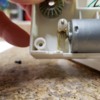Brass is a lousy gear material. Bronze or engineering plastic is what you want.
I suspect the gear makers already know this. Many people talk about brass gears when what they're really seeing is bronze gears.
Brass, bronze, steel, acetal resins....they're all good when used properly.
I'm not among those who might argue with the expertise of NorthWest Short Line, the gear people in our hobby. Improper design in the first place...and lack of proper gear lubrication probably a close second...is more often the reason gear drives fail. Re materials, their rule-of-thumb as stated in their website is...
"Improperly selected materials (most commonly a brass worm driving a brass wormgear - ie. Same materials - wear out rate will be very high, usually whether lubricated or not). Driving gear should be harder material than driven gear."
It's not a brass problem. It's whether the use of brass in a gear train sequence is appropriate or not.
NWSL further states...
"For best gear life, the gears should be dissimilar materials with the driving gear harder. This is particularly important for high speed and/or high load interfaces such as worm to wormgear and less important in low speed situations such as idler gears between axles. Acetal is the generic name for the engineering plastic trade named Delrin (DuPont) and Celcon (Celanese). NWSL acetal gears are machined from stable, aged material to avoid the shrinkage and cracking problems inherent in inexpensive moulded plastic gears. Gears can be machined in material of your choice with appropriate handling and difficulty charges (ie. gears in bronze usually require a 50% surcharge compared to brass because of added machining time and tool wear)."
...the last sentence perhaps reflecting why bronze gears may not be as OEM-prevalent or arbitrarily applied in the model railroad industry as you might suspect.
There's a lot of information on NWSL's new website (Menu: "Old Catalog Pages") about gearing design, materials, lubrication, causes of failure, etc., etc.. Again, who am I to argue with those for whom this has been a successful vocation?
TEHO/FWIW, always.
------------------
More directly to the OP's original inquiry, though, here is a link to NWSL's website showing their current 10-tooth (number of teeth is critical) spur gears, 2mm bore, availability/prices...
NWSL Link
You might send an email to NWSL to have them confirm which might be applicable to your situation.
KD
























